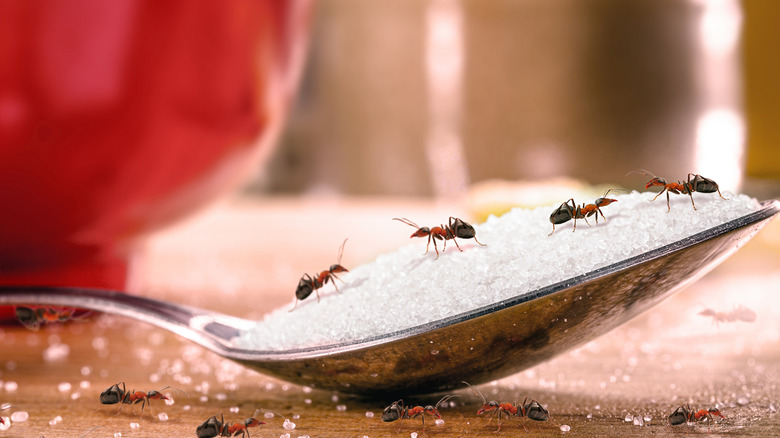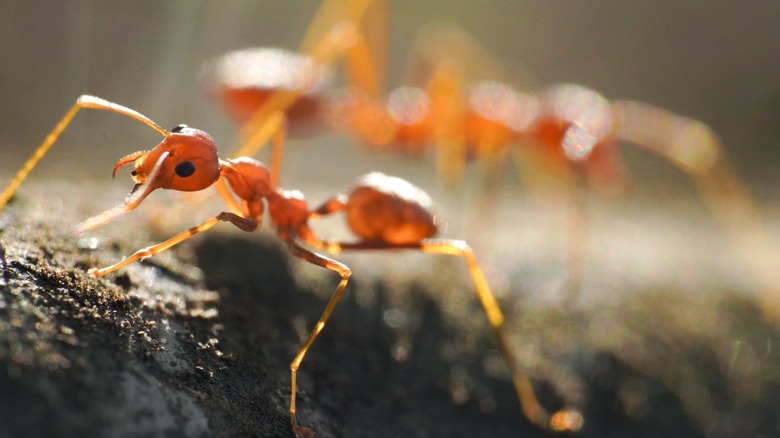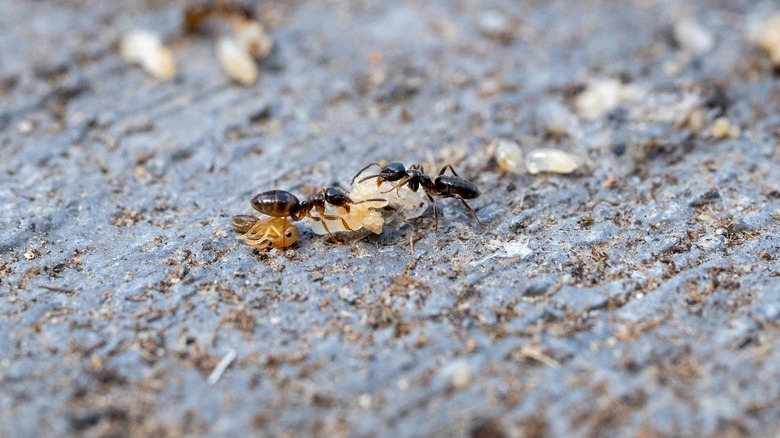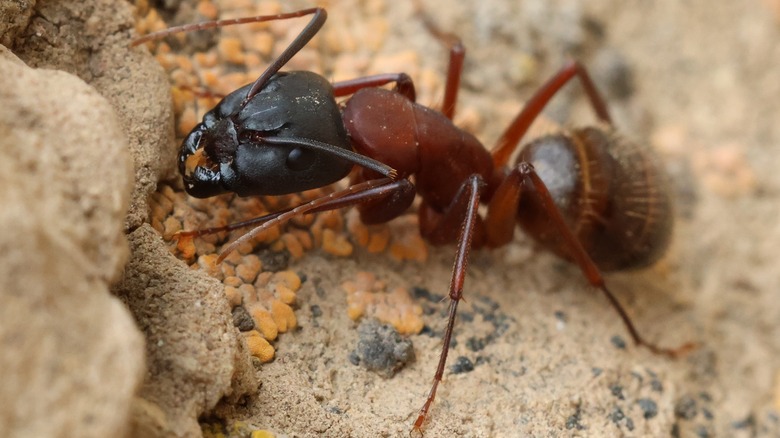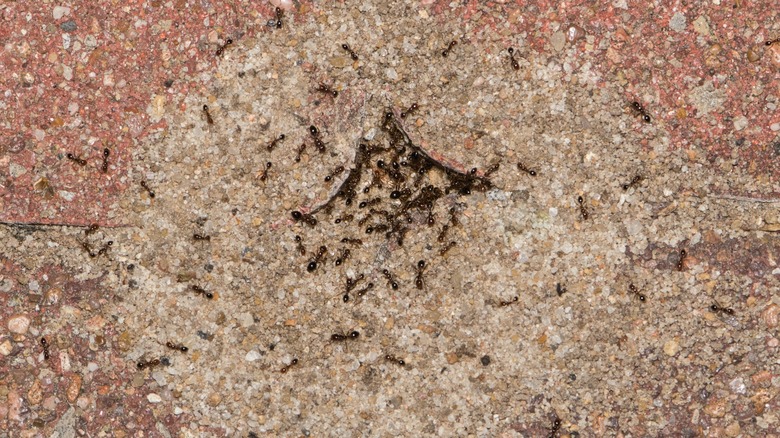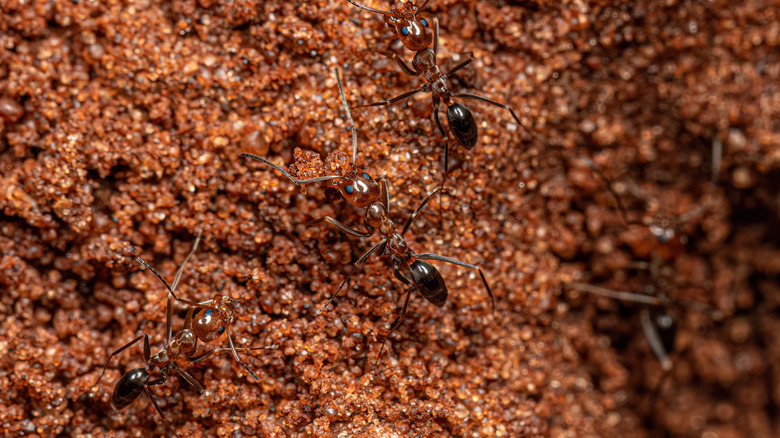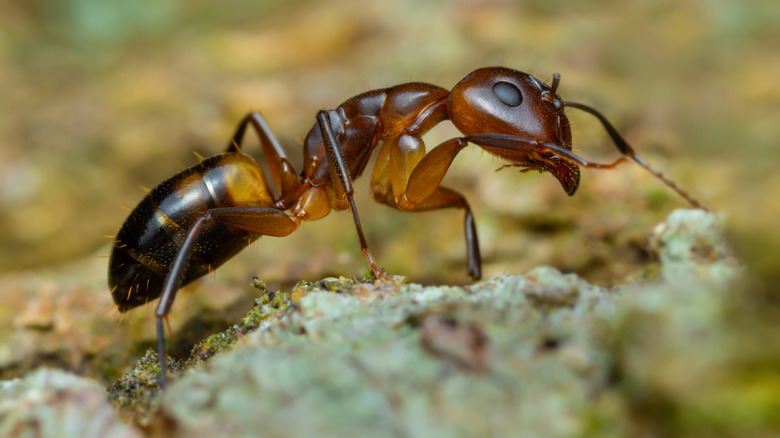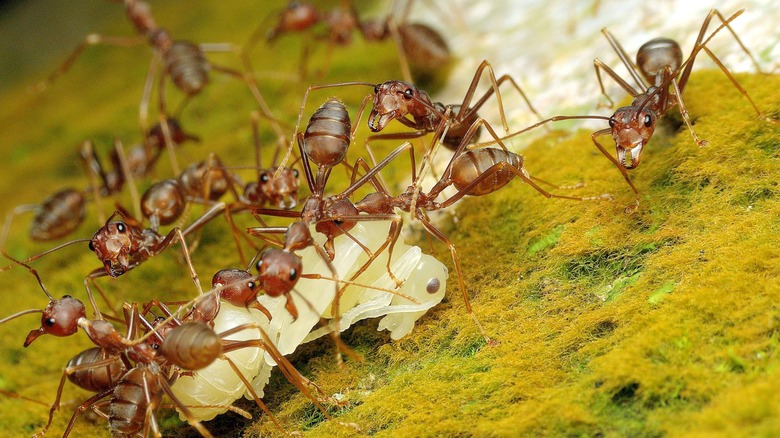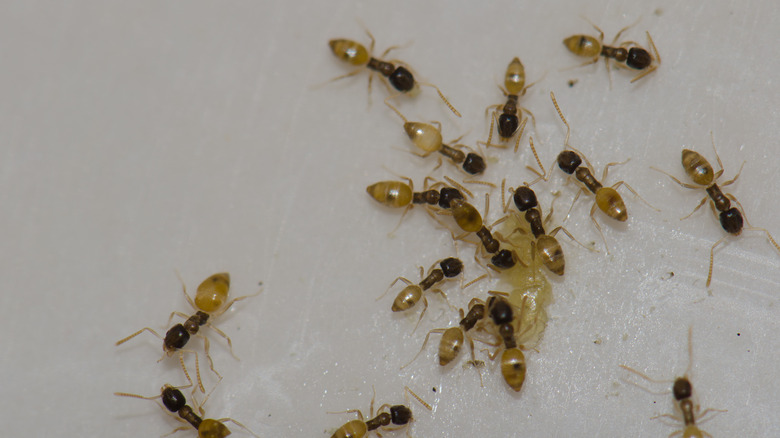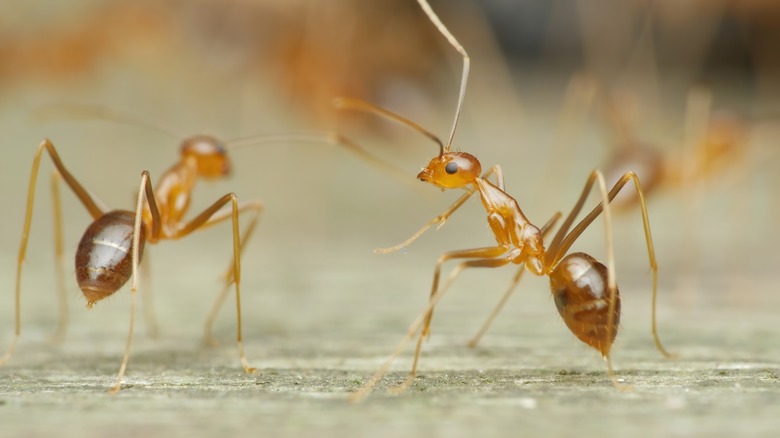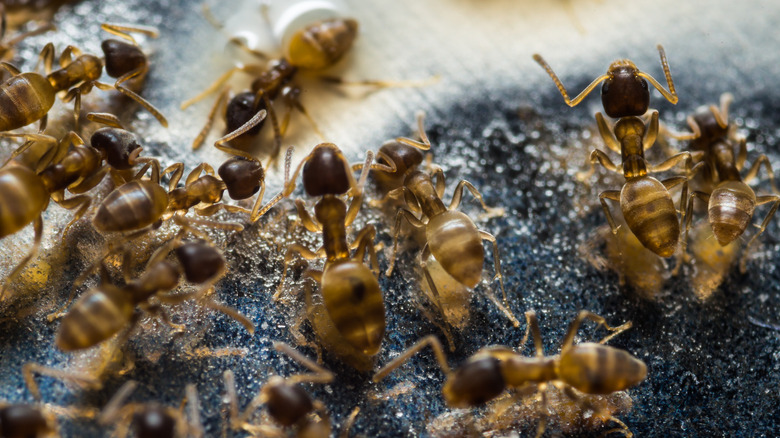What Kind Of Ant Is Plaguing Your Home (And How Do You Get Rid Of Them)
Ants are among the most common household pests, and while a few stray ants in your kitchen might seem harmless, your pest infestation might be a bigger problem than you think, as it often signals a much larger colony nearby. With more than 12,000 recognized species worldwide, ants are remarkably different in looks and habits. Some prefer sweets, while others are drawn to protein or moisture. They also don't respond the same way to all insecticides.
These differences can mean treatment that works well for one type of ant to be completely ineffective or even counterproductive against another. For some species, the correct approach involves slow-acting baits that ants carry back to the colony, while others require targeted habitat management or moisture control. Because of these differences, knowing which ant species has invaded your space can save you from frustration and ensure that you choose methods and hacks for keeping insects out of your house which work work. If you don't know what kind of ant you're dealing with, you may end up wasting time, money, and effort. This is why accurate identification is the first and most important step in tackling an infestation. Throughout this article, we'll break down the most common household ants, how to identify them, and the best strategies to get rid of the ants you have for good.
Fire ants
Fire ants are one of the most recognizable and feared ant species due to their painful stings and aggressive behavior. Unlike other ants that quietly forage, fire ants actively defend their nests. Their colonies form visible soil mounds, often in open sunny areas like lawns, fields, or along sidewalks. Their queens are a reddish brown color, while the male fire ants are black. Although they prefer outdoor environments, fire ants may find their way indoors in search of food or water, especially during extreme weather conditions.
Controlling fire ants requires more than just spraying the mound. The most effective approach recommended by experts is the two-step method. First, broadcast a slow-acting bait across the infested area so worker ants can carry it back to the colony. Then, follow up with targeted mound treatments using approved insecticides for any colonies that remain active. Consistency is key, and reapplications may be needed since fire ants are persistent and can rebuild quickly. Keeping outdoor spaces clean, mowing lawns regularly, and inspecting for new mounds can also help prevent re-infestations. When fire ants move indoors, different measures are needed. Seal cracks, gaps, and entry points around doors and windows to block access. Wiping surfaces clean and storing food in airtight containers can reduce their numbers, as there are some foods that are likely to attract fire ants to your home. Since fire ants are more aggressive than most household ants, swift action and vigilance are essential to keep them from establishing themselves inside your home.
Odorous house ants
Odorous house ants, or sugar ants, are one of the most common household pests. They get their name from the distinctive odor they release when crushed, often compared to rotten coconuts. Small in size, typically measuring 0.01 to 0.14-inches long, these ants are brown to black. They are notorious for invading kitchens and pantries in search of sweets and other food sources. Outdoors, odorous house ants typically nest under soil, plants, logs, or stones. Indoors, they often establish colonies within walls, under floors, or near moisture sources like leaky pipes.
When it comes to managing odorous house ants, the right approach matters. Traditional repellent insect sprays may worsen infestations by causing colony splitting, which makes the problem spread instead of disappear. The most effective method indoors is slow-acting ant bait. Worker ants carry the bait back to the colony, sharing it with the queen and nestmates. However, patience is necessary, as it can take up to two weeks to achieve noticeable results. Outdoors, prevention is key. Keep your yard clean by removing organic debris, trimming vegetation back from the house, and regularly inspecting for ant trails that lead toward your home. Eliminating moisture sources, such as fixing leaks, unclogging gutters, and improving drainage, also makes your home less attractive to them. With persistence and preventive measures, odorous house ants can be managed, but homeowners should expect a longer battle compared to other ant species.
Carpenter ants
Carpenter ants are among the largest and most easily identifiable ants homeowners encounter, ranging from 0.25 to 0.5 inches in length. They are usually black, though some species may appear reddish or a combination of both. Unlike termites, carpenter ants do not eat wood for nutrition. Instead, they bore into damp, decaying, or untreated wood to create smooth tunnels and chambers where they establish nests and lay eggs. Indoors, they may be spotted trailing along walls, vents, or around sinks, particularly during warmer months when colonies send out foragers to hunt for protein and sugary foods. If left untreated, carpenter ants can compromise the structural integrity of wooden components in a home.
Getting rid of carpenter ants starts with locating and eliminating their nest. Unlike some smaller ant species, spraying foragers is ineffective if the colony remains hidden in the wood. In this case, the problem will continue. Professional-grade baits and insecticides applied directly to the nest are the most effective treatments. To reduce the likelihood of infestation, address the underlying conditions that attract them. Eliminate sources of moisture by fixing leaks, improving ventilation, and replacing water-damaged wood. Outdoors, keep tree branches and shrubs trimmed away from the home, as these serve as highways for ants to gain access indoors. Sealing cracks, gaps, and other entry points around foundations, doors, and utility lines can also help prevent infiltration. Because carpenter ants can nest both inside and outside, regular inspections are critical. Early detection and direct nest treatment are key to protecting your home from long-term damage.
Pavement ants
Pavement ants are one of the most common ant species found around homes and commercial areas. True to their name, they typically nest in soil beneath sidewalks, driveways, patios, and building foundations, pushing up small mounds of soil near cracks in pavement or concrete. Originally from Europe, pavement ants were introduced to North America and have since become a widespread household pest. They are small (about 0.1 inches long), dark brown to black in color, and often gather in visible groups near cracks in pavements or along baseboards inside homes. Indoors, they forage for protein-rich or sugary foods, while outdoors they will trail toward pet food dishes, garbage areas, and dead insects.
Controlling pavement ants requires targeting both their food sources and their colonies by killing their queen. The most effective long-term strategy is to locate and eliminate nests, which may be hidden under concrete slabs, stones, or floorboards. Indoors, maintaining a clean environment is critical. Wipe up food spills immediately, take out trash regularly, and store food in sealed containers. Baits are often more effective than sprays for pavement ants, as the workers carry the bait back to the nest to share with the colony. If infestations persist, insecticides can be applied to cracks and crevices where ants are entering. Outdoors, sealing entrance cracks, improving drainage, and trimming vegetation away from foundations can help reduce nesting opportunities. With consistent sanitation, baiting, and nest control, pavement ant infestations can be managed effectively and prevented from returning.
Pyramid ants
Pyramid ants are a lesser-known species that typically do more good than harm. They get their name from the distinct pyramid-like projection on the top of their thorax, giving them a triangular head shape. Outdoors, they build volcano-shaped soil mounds with a small opening at the top, often scattered across sunny, dry lawns or fields. Unlike many nuisance ants, pyramid ants are considered beneficial because they prey on other insects, including fire ants and various pests that damage lawns and gardens. Their foraging habits generally focus on live or dead insects, along with sugary substances, such as honeydew from aphids. Despite this, large colonies and multiple mounds can become unsightly in landscaped areas.
Because pyramid ants play a positive role in controlling harmful insect populations, if they begin invading indoors, the first line of defense is sealing off entry points around windows, doors, and foundation cracks. Outside, bait methods can sometimes help manage them. However, a growing pyramid ant population in your yard may also be a sign of concerning underlying issues, such as the presence of more ants nearby that the pyramid ants are relying on for food. If colonies become too numerous, a pest control professional can apply targeted treatments that reduce the ants without harming the broader environment. Overall, while pyramid ants aren't destructive, their presence in large numbers can make lawns unattractive and warrant strategic control measures.
Argentine ants
Argentine ants are among the most frustrating ant species homeowners encounter. Unlike fire ants, they don't sting, but their nuisance level comes from the sheer size of their colonies and their relentless invasion of homes in search of food and water. Identifying them is relatively easy, as they tend to travel in well-organized trails that connect their nests to food sources. Unlike many ant species that form individual colonies, Argentine ants establish supercolonies, with multiple queens producing vast populations that can quickly overrun an area. This cooperative behavior makes them incredibly difficult to control once they get established. Argentine ants are especially drawn indoors during hot, dry weather or heavy rain, seeking out moisture in kitchens, bathrooms, and utility rooms. Once inside, they target sugary foods, pet dishes, and even grease.
Controlling Argentine ants requires more than just spraying over visible trails. In fact, contact insecticides can make the problem worse by scattering the colony and encouraging budding, where new queens break away and form additional nests. The most effective approach is baiting. Protein or sugar-based ant baits are carried back to the nest and shared among colony members, eventually reaching the queens and reducing the population. In extreme cases of infestation, given how troublesome this species of ants can get, it's advisable to get expert help in eradication. With persistence and the right methods, Argentine ant invasions can be brought under control.
Pharaoh ants
Pharaoh ants are one of the most challenging ant species to control indoors. Originally from the Afrotropical region, these ants thrive in warm, humid environments and have adapted especially well to indoor living. They are small and range in color from yellow to light brown with darker abdomens. Their size makes them difficult to detect at first, but infestations can escalate quickly since pharaoh ants form large colonies with multiple queens. They prefer heated indoor spaces, such as wall voids, baseboards, electrical outlets, and areas behind cabinets or appliances. However, in warmer or more temperate climates, they may occasionally nest outdoors in debris, soil, or cracks and crevices.
Controlling pharaoh ants requires a strategic approach. Standard contact insecticides, sprays, or repellents like RAID often backfire, causing colonies to bud. Budding occurs when stressed colonies split into multiple smaller colonies, each led by its own queen, making the infestation even worse. For this reason, slow-acting, non-repellent insecticides and baiting are the most effective control methods. Baits are especially important, because worker ants carry the toxic food back to the nest, feeding the queens and larvae, which ensures the entire colony is affected. Patience is key, as it may take a little while for baits to fully reduce the population. Prevention is just as important as treatment. Homeowners should close off entry points around windows and doors, and maintain strict cleanliness in kitchens and food storage areas. Because pharaoh ants are persistent and easily spread, infestations often require professional pest control for complete eradication.
Ghost ants
Ghost ants are small, elusive insects that can be even harder to control. Originally from tropical regions, they thrive in warm and humid environments, making them common in greenhouses, conservatories, and heated buildings in cooler climates. They are extremely tiny and are easily distinguished by their unique coloration, which is a dark head and thorax paired with a pale, almost translucent abdomen and legs. This pale appearance is what earned them the name ghost ants, since their abdomens often seem to disappear against light surfaces. Their colonies tend to be large and polygynous, which allows them to reproduce quickly and spread into multiple nesting sites. Like odorous house ants, ghost ants are particularly sugar-loving and often forage for sweets, honeydew, or other carbohydrate sources, though they also feed on protein when available.
Getting rid of ghost ants begins with eliminating harborage sites, clutter, excess moisture, and decaying organic matter where they can hide and nest. Since they are especially attracted to sweets, targeted baiting with sugar-based baits is the most successful treatment method. Worker ants carry the bait back to the colony, distributing it to the queens and larvae, which ensures the entire nest is impacted. For long-term success, non-repellent insecticides may also be used in combination with baits, as ghost ants can detect and avoid traditional repellents. Consistent monitoring and preventive maintenance are key. By sealing entry points and maintaining a clean, dry environment, homeowners can drastically reduce the chances of ghost ant infestations taking hold indoors.
Tawny crazy ants
Tawny crazy ants are an invasive species notorious for their erratic, frantic movement patterns. They nest under leaf litter, rocks, mulch, logs, and within moist soil. Their colonies are extremely dense and can grow to massive numbers, often displacing native ants and even outcompeting fire ants. Their behavior is what gives them their name, as workers move quickly and seemingly without direction, creating the impression of a crazy swarm. Tawny crazy ants do not sting, but they can cause major disruptions by invading homes, damaging electrical equipment, and overwhelming outdoor spaces with their sheer numbers. They are drawn to both sweets and proteins, making kitchens, pet food, and garbage bins especially vulnerable.
Controlling tawny crazy ants requires persistence and strategy. Repellent sprays are ineffective and may worsen the problem, as they drive the ants to scatter and form new colonies. Instead, slow-acting, non-repellent insecticides should be applied so that foragers unknowingly carry the poison back to their colonies. Early baiting is essential, as mature colonies are harder to eliminate. Rotating between sugar-based and protein-based baits increases effectiveness. Preventive measures also play an important role — sealing entry points around windows, doors, and foundation cracks keeps them from invading homes. Outdoors, homeowners should reduce moisture sources, remove piles of leaf litter, trim vegetation, and eliminate aphid populations that provide honeydew, one of the ants' favorite food sources. With consistent monitoring and layered treatment methods, tawny crazy ants can be managed before they spiral out of control.
Thief ants
Thief ants, also known as grease ants, are among the smallest household ants, often measuring 1/16 of an inch long. Their tiny size allows them to move through cracks, electrical outlets, and wall voids with ease, making infestations difficult to detect and control. True to their name, thief ants are notorious for raiding the nests of other ants, stealing food, eggs, and larvae to feed their colonies. This behavior makes them a disruptive presence both indoors and outdoors. These ants prefer greasy, protein-rich foods, but they will also feed on dead insects and almost any other available food source. Colonies are often located in soil, woodwork, baseboards, and wall voids, with multiple nesting sites connected by foraging trails. Because of their size, thief ants can easily contaminate stored food, making them both a nuisance and a potential health concern, as ants can transfer pathogens onto food.
Controlling thief ants requires patience, as their trails can be extremely difficult to spot. However, because thief ants often build multiple hidden nests, complete elimination usually requires targeted baiting. Slow-acting baits are the most effective option, as fast-acting sprays or repellents will only kill a few workers without reaching the colony. Protein- or grease-based baits are beneficial, since they align with the ants' natural food preferences. In addition, keeping your home clean, sealing food containers tightly, and reducing clutter can help limit food sources that sustain the infestation. With persistence and the right bait strategy, thief ants can be managed, though their nature often makes professional pest control necessary.
